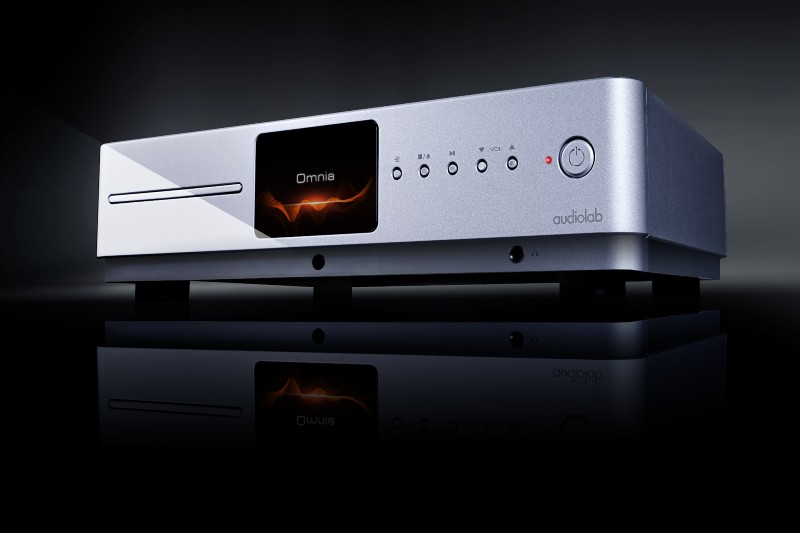Today, Audiolab released the $2299 Omnia, a classy-looking Roon Tested streaming amplifier with a built-in CD player, Play-Fi streamer, MM phono stage, and asynchronous USB input. The amp stage is Class AB (50w per ch. into 8 ohms) mated to an ESS Sabre-based digital stage (ES9038Q2M chip) which is capable of handling PCM audio up to 32-bit/768kHz, alongside DSD to 22.5MHz (DSD512) and MQA (Full decoding via Wi-Fi, Ethernet, USB, coaxial and optical inputs).
It also does Bluetooth streaming via an internal BT 5.0 receiver which is compatible with a bunch of codecs, including aptX, aptX LL, aptX HD, AAC, SBC.
The Omnia also has a wide variety of analog input and outputs on the rear panel, along with a 4.3in IPS LCD screen for status/control on the front panel. It will be available in December, in a choice of black or silver, at an MSRP of $2299.99 in the U.S.
For more pics and info see below:
The following Press Release is courtesy of Audiolab:
Great universal
From CDs and vinyl to hi-res network streaming, the Audiolab Omnia is the all-in-one, just-add-speakers hi-fi system that does it all, and does it in style
Cambridgeshire, England – Throughout its 40-year history, Audiolab has produced some of British hi-fi’s most celebrated electronics. Amps that stretch from 1982’s classic 8000A to the current, best-selling 6000A; DACs from 1992’s 8000DAC to the mighty M-DAC series of the last decade; and a range of source components that includes the award-winning 6000CDT CD transport and 6000N Play network streamer.
For its newest creation, Audiolab has distilled its know-how across these component categories into a single chassis. The result is an all-in-one, just-add-speakers music system that Audiolab calls the Omnia.
Housed in a beautifully engineered aluminium enclosure with a crisp, minimalist aesthetic, the Omnia caters for a music lover’s every need – from digital streaming to physical CD and vinyl collections. It sports an integrated CD player, extensive inputs for external sources – including a phono stage for a turntable – hi-res network streaming, the ability to form part of a synchronised multi-room system and high-quality amplification to make the most of whichever speakers or headphones the user chooses to partner it with. Most importantly, the quality of its internal design – right down to each individual circuit component – ensures that however you use it, the Omnia delivers a level of sonic performance more readily expected of bulkier and more expensive multi-component hi-fi systems.
The ideal system for every music source
Streaming has become the predominant way in which many people listen to music, which is why contemporary all-one-music systems often focus on this aspect. This is a critical part of the Omnia’s design too, with hi-res network streaming supported over dual-band Wi-Fi and Ethernet cable, alongside Bluetooth for wireless reception from smartphones, tablets and so on. But Audiolab recognises that plenty of people continue to own, and wish to listen to, physical music collections – however you choose to play your music, the Omnia has it covered.
These days, an integrated CD player is rare to find in a single-box music system. The Omnia’s transport mechanism is engineered to make the most of any still-treasured CD collection, incorporating a high-precision optical system and low-friction loading tray, with an electronic data buffer and sturdy aluminium base and chassis to tackle vibration.
For vinyl lovers, the integral MM phono stage features a high-quality, low-noise, JFET-based circuit with precise RIAA equalisation – just add your chosen turntable. Other external sources can be connected via a range of digital (asynchronous USB and S/PDIF) and line-level analogue inputs, utilising the Omnia’s high-performance DAC, analogue preamp and power amp stages. Further versatility is provided by the ability to bypass the separate amp stages, giving the option to connect an external preamplifier or power amplifier.
Inlaid in the centre of the Omnia’s aluminium front panel is a 4.3in full-colour screen, ready to display all sorts of information including system settings, format data and track details. It can even be set to display a VU meter in ‘analogue’ or ‘digital’ form, showing real-time decibel levels for the left and right channels – a satisfying graphical representation of the music as it plays.
Digital delights
Despite its attractive simplicity, the Omnia sports cutting-edge sophistication beneath the skin. At the heart of its digital circuitry nestles the ES9038Q2M – a top-spec, new-generation chipset from the eminent 32-bit Sabre family. This is accompanied by proprietary circuitry to make the most of ESS Technology’s HyperStream II architecture and Time Domain Jitter Eliminator for ultra-low noise and high dynamic range.
No company knows more about making the most of this technically excellent, but challenging to implement, DAC technology than Audiolab – the universally acclaimed M-DAC was one of the first audio components to incorporate a chip from the ESS Sabre family back in 2011, and the company has been honing its implementation ever since. One critical element is the post-DAC active filter; Audiolab’s design team has paid great attention to this circuit, using op-amps specially selected for their synergy with the Sabre DAC. All digital sources benefit from the DAC’s quality, from CDs and audio streamed over Wi-Fi or Ethernet to devices connected via the USB and S/PDIF inputs.
PCM audio is supported to 32-bit/768kHz, alongside DSD to 22.5MHz (DSD512). Every significant hi-res and lossless audio format is catered for, including FLAC, ALAC, AIFF and WAV, as well as compressed legacy formats.
The Omnia also delivers full decoding of MQA, the hi-res streaming technology. This means that the complete ‘three unfold’ decoding process is performed internally, as opposed to just the final unfold in the manner of an MQA ‘renderer’, which makes the Omnia an excellent system choice for subscribers to Tidal’s ‘HiFi Plus’ tier where Tidal Masters (MQA) content can be found.
Engineered for awesome audio
With many generations of award-winning designs under its belt, Audiolab knows a thing or two about amp design. The Omnia’s analogue circuits harness this wealth of experience to compelling sonic effect, its preamp and power amp stages incorporating short, direct signal paths and high-quality components to preserve sonic purity.
Volume is adjusted in the analogue domain under microprocessor control, outputting directly to the Class AB output stage. This delivers 50W per channel into 8 ohms, with maximum current of 9 Amps into difficult loads – sufficient to drive whichever speakers the user chooses to pair with the Omnia.
Many all-in-one streaming systems use Class D amplification, favoured for its space-saving, cool-running power and efficiency. However, Class D designs can sound somewhat hard and sterile; Audiolab’s Class AB amp circuitry gives the Omnia a sonic advantage, coupling engaging energy with subtlety, openness and warmth.
The output stage uses a CFB (Complementary Feedback) topology, ensuring superior linearity and excellent thermal stability, as the idle current is kept independent of the temperature of the output transistors. A substantial 200VA toroidal transformer, followed by 4x15000uF reservoir capacity (60000uF in total), helps the Omnia to maintain firm control of the music whilst enabling excellent dynamic range.
Much effort has gone into the physical layout of the Omnia’s circuitry, protecting the sensitive preamp section from noise interference. This, plus the use of independent low-noise power supplies for critical stages, helps to give the Omnia a clear sonic edge over other comparably priced all-in-one systems.
A streamer’s dream
Network streaming is powered by DTS Play-Fi: an app-controlled platform enabling high-quality, whole-home wireless audio, capable of streaming hi-res music up to 24-bit/192kHz and supported by a greater range of established audio brands than any other wireless platform.
The Play-Fi app (available for iOS, Android and Kindle Fire devices, Apple and Android smartwatches, and Windows PCs) is an intuitive gateway to a wealth of music services, including Spotify, Tidal, Amazon Music, Deezer, Qobuz, Audacy, TuneIn, iHeartRadio and SiriusXM. It is also your trusty music butler, able to serve up a streaming library stored on a DLNA-compatible NAS drive or media server.
Favourite playlists and internet radio stations can be assigned as shortcut ‘presets’ within the app, while Works With Alexa support enables voice-controlled playback when the Omnia is paired with any Amazon Alexa-equipped device.
In standard mode, which is optimised for multi-room bandwidth, Play-Fi streams at up to 16-bit/48kHz – akin to CD-quality. By engaging Play-Fi’s Critical Listening Mode, hi-res audio up to 24-bit/192kHz may be streamed to the Omnia over Wi-Fi or Ethernet cable, without transcoding or down-sampling.
There are ways to stream music wirelessly to the Omnia other than using the Play-Fi app. Users can play directly from the Spotify app thanks to Spotify Connect, and stream from smartphones and tablets without connecting to the local Wi-Fi network via Bluetooth – the Omnia is Bluetooth 5 compliant for optimum quality, reliability and range, and includes decoding for aptX, aptX LL, AAC and SBC.
The Omnia is also officially ‘Roon Tested’, meaning it has been put through its paces rigorously by Roon and certified for use in a Roon audio environment.
Making connections
As well as the built-in CD player and wireless streaming over Wi-Fi and Bluetooth, the Omnia offers a comprehensive selection of cable inputs for analogue and digital sources. Two USB inputs, Type A and Type B, cater for connection to PCs, Macs, smartphones, tablets and digital storage devices, complemented by four S/PDIF digital inputs (two coaxial and two optical) and an Ethernet port for network connectivity. Four stereo RCA analogue inputs are supplied – three line-level, plus one MM phono input for a turntable.
In addition to a set of high-quality, gold-plated binding posts to connect the user’s chosen speakers, headphone fans are served by a front-mounted 6.3mm headphone output fed by a dedicated amp; with its current-feedback design and high slew rate, a dynamic and detailed performance with all manner of headphones is assured. Other outputs include a stereo-RCA pre-out option, as well as coaxial and optical digital outputs.
The Audiolab Omnia is available in December, in a choice of black or silver, at an RRP of £1,599.










Leave a Reply